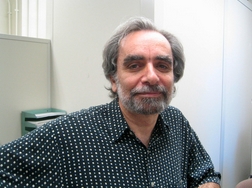 I love hearing Vania Apkarian speak. He is always so positive about his data and so forthright in his views that you have no doubt what he thinks and no doubt that he loves going to work. This workshop I went to today was no exception – it was Apkarian at his best. And, quite possibly, he has good reason to be excited. His group at NorthWestern in Chicago has been working for over a decade on functional and structural brain imaging in people with chronic pain. Indeed, he makes a real point of making sure that his team of students and post-docs are acknowledged for their monumental contributions. Over that time, his group has stamped its name on much of what is known about the brain of people in chronic pain. Here is a bit of what his group, and others, have discovered:
I love hearing Vania Apkarian speak. He is always so positive about his data and so forthright in his views that you have no doubt what he thinks and no doubt that he loves going to work. This workshop I went to today was no exception – it was Apkarian at his best. And, quite possibly, he has good reason to be excited. His group at NorthWestern in Chicago has been working for over a decade on functional and structural brain imaging in people with chronic pain. Indeed, he makes a real point of making sure that his team of students and post-docs are acknowledged for their monumental contributions. Over that time, his group has stamped its name on much of what is known about the brain of people in chronic pain. Here is a bit of what his group, and others, have discovered:
- – That acute evoked pain and spontaneous pain is associated with different ‘signatures’ of activity in the brain. Activation of the insula seems to code best for thermally evoked pain, and medial prefrontal cortex seems to code for spontaneous pain. Indeed, mPFC activation during spontaneous pain reports can differentiate between chronic back pain and other types of chronic pain.
- – As pain persists, so too does the neural signature shift from a sensory-dominant to an emotional-dominant one, although the same broad areas are involved in both.
- – Regional gray matter changes in chronic pain depend on the type of the chronic pain – or the location perhaps. The thing that is consistent is that the gray matter changes are not distributed across the brain, as they are for normal, or pain-free, controls.
- – For evoked pain, Apkarian is most excited about the data relating to the nucleus accumbens (NAc). He reckons that activation of the NAc during evoked pain differentiates between chronic back pain patients and healthy controls pretty much all the time. In fact, when a noxious stimulus is delivered, controls have an increase in NAc when the stimulus stops (which is consistent with reward system activation and NAc is important for reward), but for patients, there is a decrease in NAc activation at the same time. Apkarian reckons this is about value judgements of the pain – more on that in a bit.
- – The functional connectivity between NAc and mPFC is only present in cbp and not in healthy controls and the extent of this connectivity correlates with spontaneous pain with a correlation of a whopping r=0.86. Apkarian said a few times that he could determine how bad a chronic pain patient’s pain was on a given day by looking at mPFC activation during spontaneous pain. I could answer the same question without getting out the scanner but I don’t think that was his point. So, NAc seems important – Nestler et al < > reviews the data on NAc and conclude it does a fair bit (which, it seems is pretty much normal for functional neuroanatomy stuff), including reward expectancy, decision making under uncertainty, habit formation, stress and now, thanks to Apkarian, it is important in pain.
- – Apkarian’s Piece de resistance was a longitudinal study in which he got 39 acute back pain patients – 4 – 12 weeks in – with pain over 5/10, and followed them with 4 scans over the following year (the amount of grants we have NOT got proposing this very thing makes me groan for a second, but let’s move on). The short story: nearly all the changes we see in people with chronic pain develop as the pain develops, and there was almost nothing different at entry between those who go onto chronicity and those who do not, with one significant difference – those who still had pain unchanged at 1 year could be identified at entry by the connectivity between NAc and mPFC, with an odds ratio of about 5. If early treatment and the presence of radicular pain was added to the model, the odds ratio was 13, although the 95% CI was pretty big – 2 – 66, so the size of the effect is a bit hard to nail down. Still, it is, as it stands, a huge finding and one that will be out in Nat Neurosci some time soon.
Apkarian is sure this relationship between NAc-mPFC and chronicity is causal (as sure as he is that catastrophising doesn’t exist, but that is for another day). One question I am hoping that Vania responds to before this posts is whether or not the NAc-mPFC effect could have emerged between injury and entry to the study. NEWS FLASH – he has, he said that he presumes it reflects the individual’s response or interpretation of their injury, but that it remains to be shown. There are recent data that connectivity changes can occur as little as 2 weeks in a learning model, which would seem to support this possibility.
A final reflection here is that Apkarian reckons this NAc effect reflects a value judgement on the pain – sounds like something that might help from an intervention that could help the patient reconceptualise their pain…..
On Vania Apkarian – this is what his website at NorthWestern University in Chicago says: Dr. Apkarian has been studying pain for over two decades, both in animal models and fMRI studies in humans. His current interests include cortical dynamics of pain as well as brain plasticity. His overall goal is the uncovering of brain mechanisms underlying PAIN QUALIA. This work aims to alleviate clinical pain conditions and achieve a more profound theoretical and mechanistic understanding of the brain. It should also say that he is Professor of Physiology, Surgery & Anesthesia at NorthWestern University, has received enough grant money to support a medium sized country, written 130 papers, 20 book chapters and 2 books. He is a real life heavyweight so we should all take notice.
[Update: 12 Dec 2012 – the link NorthWestern University is no longer working but this is what it said in May! ]
About Lorimer Moseley
 Lorimer is NHMRC Senior Research Fellow with twenty years clinical experience working with people in pain. After spending some time as a Nuffield Medical Research Fellow at Oxford University he returned to Australia in 2009 to take up an NHMRC Senior Research Fellowship at Neuroscience Research Australia (NeuRA). In 2011, he was appointed Professor of Clinical Neurosciences & the Inaugural Chair in Physiotherapy at the University of South Australia, Adelaide. He runs the Body in Mind research groups. He is the only Clinical Scientist to have knocked over a water tank tower in Outback Australia.
Lorimer is NHMRC Senior Research Fellow with twenty years clinical experience working with people in pain. After spending some time as a Nuffield Medical Research Fellow at Oxford University he returned to Australia in 2009 to take up an NHMRC Senior Research Fellowship at Neuroscience Research Australia (NeuRA). In 2011, he was appointed Professor of Clinical Neurosciences & the Inaugural Chair in Physiotherapy at the University of South Australia, Adelaide. He runs the Body in Mind research groups. He is the only Clinical Scientist to have knocked over a water tank tower in Outback Australia.
Link to Lorimer’s published research here. Downloadable PDFs here.



